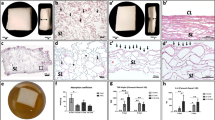Abstract
Purpose
To assess whether the size distribution of gelatin sponge particles differed according to the method used to make them and the type of original sheet.
Methods
Gelatin sponge particles of approximately 1–1.5 × 1–1.5 × 2 mm were made from either Spongel or Gelfoam sheets by cutting with a scalpel and scissors. Particles were also made of either Spongel or Gelfoam sheets by pumping with two syringes and a three-way stopcock. The size distribution of the particles in saline was compared among the groups.
Results
(1) Cutting versus pumping: When Spongel was used, cutting produced lower rates of smaller particles ≤500 μm and larger particles >2000 μm compared with pumping back and forth 30 times (1.1% vs 37.6%, p < 0.0001; 2.2% vs 14.4%, p = 0.008). When Gelfoam was used, cutting produced lower rates of smaller and larger particles compared with pumping (8.5% vs 20.4%, p = 0.1809; 0% vs 48.1%, p < 0.0001). (2) Spongel versus Gelfoam: There was no significant difference in the size distribution of the particles between Spongel and Gelfoam (p = 0.2002) when cutting was used.
Conclusion
The size distribution of gelatin sponge particles differed according to the method used to make them. More uniform particle sizes can be achieved by cutting than by pumping.



Similar content being viewed by others
References
Gold RE, Grace DM (1975) Gelfoam embolization of the left gastric artery for bleeding ulcer: Experimental considerations. Radiology 116:575–580
Vlahos L, Benakis V, Dimakakos P, et al. (1980) A comparative study of the degree of arterial recanalization in kidneys of dogs following transcatheter embolization with eight different materials. Eur Urol 6:180–185
Sniderman KW, Sos TA, Alonso DR (1981) Transcatheter embolization with gelfoam and avitene: The effect of sotradecol on the duration of arterial occlusion. Invest Radiol 16:501–507
Jander HP, Russinovich NA (1980) Transcatheter gelfoam embolization in abdominal, retroperitoneal, and pelvic hemorrhage. Radiology 136:337–344
Siskin GP, Englander M, Stainken BF, et al. (2000) Embolic agents used for uterine fibroid embolization. AJR Am J Roentgenol 175:767–773
Sonomura T, Yamada R, Kishi K, et al. (1997) Dependency of tissue necrosis on gelatin sponge particles size after canine hepatic artery embolization. Cardiovasc Intervent Radiol 20:50–53
Spies JB, Benenati JF, Worthington-Kirsch RL, et al. (2001) Initial experience with use of tris-acryl gelatin microspheres for uterine artery embolization for leiomyomata. J Vasc Interv Radiol 12:1059–1063
Pelage JP, Dref OL, Beregi JP (2003) Limited uterine artery embolization with tris-acryl gelatin microspheres for uterine fibroids. J Vasc Interv Radiol 14:15–20
Laurent A, Wassef M, Maurice JPS, et al. (2006) Arterial distribution of calibrated tris-acryl gelatin and polyvinyl alcohol microspheres in a sheep kidney model. Invest Radiol 41:8–14
Matsui O, Kadoya M, Yoshikawa J, et al. (1993) Small hepatocellular carcinoma: Treatment with subsegmental transcatheter arterial embolization. Radiology 188:79–83
Oguni T, Korogi Y, Yasunaga T, et al. (2000) Superselective embolisation for intractable idiopathic epistaxis. Br J Radiol 73:1148–1153
Yamashita Y, Takahashi M, Ito M, et al. (1991) Transcatheter arterial embolization in the management of postpartum hemorrhage due to genital tract injury. Obstet Gynecol 77:160–163
Katsumori T, Nakajima K, Mihara T, et al. (2002) Uterine artery embolization using gelatin sponge particles alone for symptomatic uterine fibroids: Midterm results. AJR Am J Roentgenol 178:135–139
Correll JT, Prentice HR, Wise EC (1945) Biological investigations of a new absorbable sponge. Surg Gynecol Obstet 81:585–589
Sangro B, Bilbao I, Herrero I, et al. (1993) Partial splenic embolization for the treatment of hypersplenism in cirrhosis. Hepatology 18:309–314
Mori H, Saida Y, Watanabe Y, et al. (2000) Rapid production of gelatin sponge particles for transcatheter arterial embolization: Pumping method. Nippon Acta Radiol 60:702–704
Acknowledgments
No financial support was received from any companies or organizations.
Author information
Authors and Affiliations
Corresponding author
Rights and permissions
About this article
Cite this article
Katsumori, T., Kasahara, T. The Size of Gelatin Sponge Particles: Differences with Preparation Method. Cardiovasc Intervent Radiol 29, 1077–1083 (2006). https://doi.org/10.1007/s00270-006-0059-y
Published:
Issue Date:
DOI: https://doi.org/10.1007/s00270-006-0059-y




